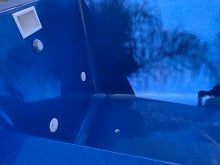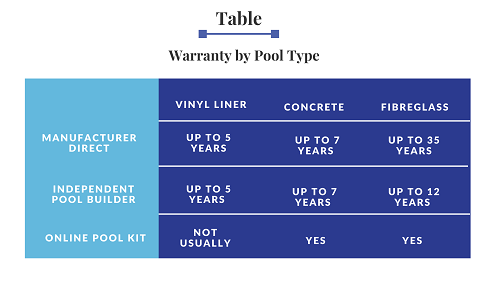How long do swimming pools last?
Fibreglass v concrete v vinyl liner swimming pool shells and how long they last is a common question. Whether a DIY pool or not, a well-maintained fibreglass or concrete pool will last a very long time however there are big differences in warranties and maintenance costs.
Fibreglass Pool Shell
The smooth surface layer of a DIY fibreglass pool shell that you can see through the water is called gelcoat. It has been around for 50 years in pools and is used on the hulls of multi-million dollar boats. Older fibreglass pools could bubble from ground water pushing through layers of the pool (called osmosis) and these were considered to be structurally weaker than concrete pools. Due to scientific improvements from the 1990’s, fibreglass pool shells have consistently outlasted vinyl liner and concrete pools in terms of needing to be resurfaced, strength and warranties. In the 2000’s, coloured gel coats were developed which replaced the standard white marine gel coat.
 Quality DIY fibreglass pool shell manufacturers offer 35 year lifetime structural warranties and up to 20 year internal cosmetic warranties against fading and cracking (Disclaimer – we bought our former home with a 25 year old fibreglass pool, which is now a 30 year old pool. No cracks, bubbling or leaks and still going strong so I’m a first-hand believer!). Why the long warranties? Technology advanced so much in the 1990’s that manufacturers are seeing their inground fibreglass pool shells still standing strong after 30 and 40 years without needing to be replaced. Pool manufacturers are using the same gelcoat that prestige boat builders are using on $100m super yachts which means darker colours won’t fade like a vinyl liner pool.
Quality DIY fibreglass pool shell manufacturers offer 35 year lifetime structural warranties and up to 20 year internal cosmetic warranties against fading and cracking (Disclaimer – we bought our former home with a 25 year old fibreglass pool, which is now a 30 year old pool. No cracks, bubbling or leaks and still going strong so I’m a first-hand believer!). Why the long warranties? Technology advanced so much in the 1990’s that manufacturers are seeing their inground fibreglass pool shells still standing strong after 30 and 40 years without needing to be replaced. Pool manufacturers are using the same gelcoat that prestige boat builders are using on $100m super yachts which means darker colours won’t fade like a vinyl liner pool.
Today, gelcoat has advanced to a level where there are dozens of colour choices and patterns to choose from (they’ve yet to come up with a tartan option). A shimmer look is achieved by adding a shiny sparkle material to the gelcoat which then reflects the sunlight.
If a fibreglass pool shell does need to be resurfaced, the cost can be between $7,000 and $11,000.
Vinyl Liner Pool Shell
Assuming correct installation and no leaks that rust the metal panels, there are vinyl liner pools that have lasted well over 10 years without needing a liner replacement. This is usually in milder climates, where the pool is partially shaded. As a general rule, the polymer in the liner of the pool will breakdown over time and needs to be replaced every 5 to 8 years. This costs between $4,000 and $6,000 to do. The plus side is you get the chance to change the look of your pool if you decide a colour change is needed at the time of replacement.
Another consideration - I know you’d never go into a pool with a wine glass. However, if that Black Sheep Aunt did and it broke, you might be up for a new liner if the broken glass slices through the liner.
Darker coloured liners absorb more sunshine (yay, a warmer pool) however the UV light will bleach the new liner more quickly. If you use chlorine rather than salt, it will bleach quicker still.
DIY Vinyl liner pools will usually have a 5-year replacement warranty however check that it is a full warranty and not prorated. A prorated warranty means the cost of repairs or replacement the manufacturer pays you, reduces each year the pool is in the ground. A full warranty means the pool will either be replaced or repaired in full by the manufacturer while in the warranty period.
Concrete Pool Shell
A concrete pool shell will last for a long time. If the pool is installed in a ground that is prone to moving, (or worse, earthquakes), this rigid strength can cause cracking. Outside of this, generally you won’t have issues if the pool is well built. Concrete pool builders generally offer a 7-year structural warranty against leaks and cracking, with various warranties for the waterline tiling - usually around 2 years.
The plaster surface layer (that goes over the concrete like plaster in a house over brickwork) is porous, breaks down and usually needs to be  replaced every 10 to 15 years. Costs range between $8,000 and $25,000 depending on the size and shape of the pool. There is a fair amount of work in removing the 13-15mm of plaster and waterline tiles so it isn’t cheap. Pebblecrete is a more durable surface material compared to plaster. Pebblecrete has .5mm to 2mm stones and glass mixed through the plaster which allows colour choice and a shimmer effect similar to fibreglass pools. It is more expensive when building the pool, and to replace, however it tends to last longer than plaster. By fully tiling the interior of the pool, you can reduce resurfacing costs. However, the upfront cost of tiling a pool can make the average person faint so do your sums!
replaced every 10 to 15 years. Costs range between $8,000 and $25,000 depending on the size and shape of the pool. There is a fair amount of work in removing the 13-15mm of plaster and waterline tiles so it isn’t cheap. Pebblecrete is a more durable surface material compared to plaster. Pebblecrete has .5mm to 2mm stones and glass mixed through the plaster which allows colour choice and a shimmer effect similar to fibreglass pools. It is more expensive when building the pool, and to replace, however it tends to last longer than plaster. By fully tiling the interior of the pool, you can reduce resurfacing costs. However, the upfront cost of tiling a pool can make the average person faint so do your sums!

Key Takeaway – Vinyl liners will get you swimming sooner if budget is a challenge. Be mindful of the cost over 10 years with having to replace the liner though. Concrete gives you design flexibility however is the most expensive to install and for ongoing internal surface maintenance. DIY fibreglass pools will last the longest and need the least amount of surface maintenance.
Related Blogs
Installing a pool is a big deal—it’s not just about cooling off on a scorching summer’s day; it’s about creating that ultimate backyard escape where friends and family can make memories for years to....
There’s nothing like stepping into your DIY plunge pool after a long day. You installed it, you love it, and it’s your little slice of paradise. Just like your lawn, your pool isn’t set and forget -....
You're envisioning the perfect backyard—relaxing by a pool that suits your style, your budget, and your maintenance limits. But with so many choices, where do you even begin? Do you go with the....
About The Author
My wife and I grew up playing in swimming pools. Our daughters learnt to swim in our backyard fibreglass swimming pool. There is nothing quite like hearing kids splashing about and giggling. As pools do, our pool became a social magnet for friends, family and neighbours which we loved. Helping customers to have their own pool and saving customers thousands on their pool and equipment is the best job in the world.




















.jpeg)


